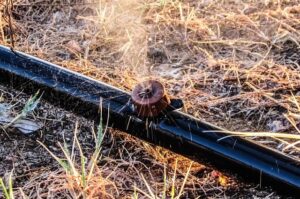If you’ve got a green thumb, you care about your garden.
But a normal sprinkler or just walking around with a hose won’t cut it. This is especially true if you have a large garden.
You need a water irrigation system that will stop you wasting water and look after your garden even when you aren’t around.
Did you know that in Western Australia we use around 40% of our drinking water in the gardens?
That is a significant percentage of our water resources, so it’s time we started becoming water-wise and implementing waterwise irrigation.
Did you know we are certified Waterwise Garden Irrigators?

This means our Perth Reticulation Experts team don’t just know how to repair, optimise and install waterwise reticulation systems, but we can also help you take advantage of the latest offers and rebates from the Water Corporation, or help you claim a leak allowance if you are eligible.
Talk to us today to find out more and how we can help you!
But in the meantime, here are some ways you can become more waterwise with how you irrigate your garden…
1. Deliver Water To The Root Zone With Waterwise Irrigation
One of the greatest inventions in gardening were the soaker hose and drip irrigation systems.

These systems allow a good 90% of the water to get to your plants’ roots. Compare this to the 40-50% that gets to your plants’ roots with a sprinkler system of some sort.
You’re looking to reduce evaporation and keep those areas between plants dry. If you can do this, you minimize weed growth as well. The weed seeds have no moisture to help them spawn and take root in your soils.
You can do this with an automated, drip line irrigation system. Make sure to have it professionally installed and optimised so you know it meets all your gardens needs, and is getting the right amount of water everywhere it is needed.
2. Use Quality Irrigation Parts
Not all sprinkler heads and reticulation parts are the same. We use brands like Toro and Hunter, but also stay abreast of the latest industry updates so that the parts we use do what they are designed to and last. Otherwise you don’t just waste water when they leak, break or don’t do what they are supposed to, but you end up wasting time and money by replacing them more often than needed.
3. Check Your System Coverage
Sprinkler heads are all designed to deliver water at different rates and have varying radius capabilities, so it’s important to choose carefully so that you get the right amount of coverage and the right amount of water delivery. You want to make sure you have what is called head-to-head coverage. Which basically means making sure there are no gaps or ‘dry zones’ in between your sprinkler heads. This is often the case when you see dry or dead spots appearing in your lawns. A smart, waterwise irrigation installer will be able to make sure that there are no ‘dry zone’ spots, and in the flip side, that your coverage doesn’t overlap so much that areas are getting overwatered and soggy.
4. Test Your System Regularly
This doesn’t have to be complicated and you don’t need to be an expert. We suggest that you simply either watch your system run during its scheduled time every few weeks, or run it manually. Keep an eye out for:
- Leaks. This is the obvious one but look out for soggy patches after the system runs where there might be a leak or break underground, or water coming from places it shouldn’t be.
- Coverage. See if you notice places where your sprinkler water sprays aren’t meeting up or crossing over or spots that stay mostly dry even after the system has run.
- Wet patches. Check your hardscaped areas like driveways and pathways – are they wetter than the grass? Look for dark patches or where water is pooling and you might need to change the direction or radius of a sprinkler to keep the water directed to where it is needed.
- Blockages. Has your hedge grown and is now blocking a plant or two from getting any water from their sprinkler head? Maybe the grass has grown over a popup which can’t pop up anymore. Keeping an eye on how your garden is growing and keeping up with maintenance or adjusting your sprinklers or system to suit is important.
- Breakages. You wouldn’t believe how many heads have broken and been creating a fountain every time the system runs but haven’t been noticed in weeks because the system runs at 6am and no one is home.
5. Improve Your Soil
Another way you can maximise the value of a good reticulation system is by creating healthy soil that supports water absorption and retention. All soil is permissible, but not all soil is beneficial. Too bad that’s not actually a gardening proverb. But you can go ahead and write it down.
Sand and clay are probably the worst soils to plant in on the face of the earth. One is like a sieve, the other is like a sponge. And neither of them are great at getting the water to your roots. But if you live here in Perth like we do, you are all too familiar with both.

If you’re going to install a waterwise irrigation system, it pays to make your soil ready to accept the water you’re putting in it. Add organic matter to the soil to enrich it.
Leaves, compost, manures, all of these things will improve the texture of your soil and increase the water holding capacity.
Make sure you add an inch every year. It’s really good for those plants.
Organic mulch is great for cutting water needs, even when you have a waterwise irrigation system installed.
These mulches will increase that humidity around your plants by retaining water.
Read here for a great article on the benefits of mulch in your garden here in Perth.
6. Mulch Your Garden
Speaking of mulch, while we can’t help with installing it for you – we’ll leave that to the Perth gardening experts, we definitely recommend it for your garden! We can set up your irrigation system expertly and make sure it is optimised, but in the end, you only get two watering days a week. Mulching your gardens with the right type and thickness helps your soil and plants retain every drop that our system delivers to them.
Try to find a thick, chunky style which lets water in and takes longer to break down, and ask your gardening team to advise on the right thickness so that your garden gets every benefit it can from water retention and a reduction in evaporation.
7. Test Your Water Application Rate
This does two things, it makes sure that your water is being distributed evenly, but also that the right amount is being applied. Sometimes your water pressure can change, or parts can break down or stop working efficiently, and this results in more or less water making it through your system and your sprinklers to your garden.
There is a simple way to do this called the ‘catch cup’ method. You can use any type of dish or cup if you have a way to measure how much they collect, or buy some at your local irrigation supply store.
Distribute them around the area you want to test, run your system and then check how much water they have collected. You are looking for around 10ml in each for one watering time. So if they were already filled to 10ml by halfway through your system’s run time, you will want to reduce the run time or book a reticulation service and get a technician to check and optimise your system to make sure you are operating as waterwise as possible.
8. Install an Isolation Valve
If the worst should happen and your system springs a massive leak, you need to be able to shut off the water to your system immediately to save wasting serious amounts of water. Every property with a reticulation system should have or install a manual isolation valve which lets you cut off water to the system without having it cut it to your house as well.
We still get calls from people who need an emergency call out because they have had to cut the water to their entire house until a technician can get there and fix the system. You don’t want to get caught in that situation! Check if you have one today and if you don’t, get in touch with us and we can organise to install one for you.
Conclusion: Make Sure Your Irrigation System Is Waterwise
These are just some of the many ways to increase your system’s efficiency and ensure you have waterwise irrigation. Like we said at the beginning, your garden deserves to keep all the water you put in it. And that’s why you need an efficient water system.
Don’t wait another minute. If you need a new waterwise irrigation system, or help optimising the one you have now, contact us.

